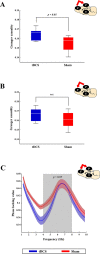The Effects of Transcranial Direct Current Stimulation on the Cognitive and Behavioral Changes After Electrode Implantation Surgery in Rats
- PMID: 31156472
- PMCID: PMC6531794
- DOI: 10.3389/fpsyt.2019.00291
The Effects of Transcranial Direct Current Stimulation on the Cognitive and Behavioral Changes After Electrode Implantation Surgery in Rats
Abstract
Postoperative delirium can lead to increased morbidity and mortality, and may even be a potentially life-threatening clinical syndrome. However, the neural mechanism underlying this condition has not been fully understood and there is little knowledge regarding potential preventive strategies. To date, investigation of transcranial direct current stimulation (tDCS) for the relief of symptoms caused by neuropsychiatric disorders and the enhancement of cognitive performance has led to promising results. In this study, we demonstrated that tDCS has a possible effect on the fast recovery from delirium in rats after microelectrode implant surgery, as demonstrated by postoperative behavior and neurophysiology compared with sham stimulation. This is the first study to describe the possible effects of tDCS for the fast recovery from delirium based on the study of both electroencephalography and behavioral changes. Postoperative rats showed decreased attention, which is the core symptom of delirium. However, anodal tDCS over the right frontal area immediately after surgery exhibited positive effects on acute attentional deficit. It was found that relative power of theta was lower in the tDCS group than in the sham group after surgery, suggesting that the decrease might be the underlying reason for the positive effects of tDCS. Connectivity analysis revealed that tDCS could modulate effective connectivity and synchronization of brain activity among different brain areas, including the frontal cortex, parietal cortex, and thalamus. It was concluded that anodal tDCS on the right frontal regions may have the potential to help patients recover quickly from delirium.
Keywords: brain stimulation; connectivity; delirium; electrophysiology; rat; transcranial direct current stimulation.
Figures







Similar articles
-
The impact of prefrontal transcranial direct current stimulation (tDCS) on theory of mind, emotion regulation and emotional-behavioral functions in children with autism disorder: A randomized, sham-controlled, and parallel-group study.Autism Res. 2022 Oct;15(10):1985-2003. doi: 10.1002/aur.2803. Epub 2022 Sep 7. Autism Res. 2022. PMID: 36069668 Clinical Trial.
-
Effects of anodal transcranial direct current stimulation over motor cortex on resting-state brain activity in the early subacute stroke phase: A power spectral density analysis.Clin Neurol Neurosurg. 2024 Feb;237:108134. doi: 10.1016/j.clineuro.2024.108134. Epub 2024 Jan 26. Clin Neurol Neurosurg. 2024. PMID: 38335706 Clinical Trial.
-
Modulating oscillatory brain activity correlates of behavioral inhibition using transcranial direct current stimulation.Clin Neurophysiol. 2012 May;123(5):979-84. doi: 10.1016/j.clinph.2011.09.016. Epub 2011 Oct 12. Clin Neurophysiol. 2012. PMID: 21995999
-
Transcranial Direct Current Stimulation in ADHD: A Systematic Review of Efficacy, Safety, and Protocol-induced Electrical Field Modeling Results.Neurosci Bull. 2020 Oct;36(10):1191-1212. doi: 10.1007/s12264-020-00501-x. Epub 2020 May 16. Neurosci Bull. 2020. PMID: 32418073 Free PMC article.
-
Neuroimaging and neuromodulation approaches to study eating behavior and prevent and treat eating disorders and obesity.Neuroimage Clin. 2015 Mar 24;8:1-31. doi: 10.1016/j.nicl.2015.03.016. eCollection 2015. Neuroimage Clin. 2015. PMID: 26110109 Free PMC article. Review.
Cited by
-
Postoperative cognitive dysfunction in elderly postcardiac surgery patients: progress in rehabilitation application research.Front Rehabil Sci. 2024 Dec 17;5:1525813. doi: 10.3389/fresc.2024.1525813. eCollection 2024. Front Rehabil Sci. 2024. PMID: 39741908 Free PMC article. Review.
-
Cognitive Function Improvement in Mouse Model of Alzheimer's Disease Following Transcranial Direct Current Stimulation.Brain Sci. 2020 Aug 12;10(8):547. doi: 10.3390/brainsci10080547. Brain Sci. 2020. PMID: 32806774 Free PMC article.
-
Repeated tDCS at Clinically Relevant Field Intensity Can Boost Concurrent Motor Learning in Rats.J Neurosci. 2025 May 14;45(20):e1495242025. doi: 10.1523/JNEUROSCI.1495-24.2025. J Neurosci. 2025. PMID: 40216548
-
Different paradigms of transcranial electrical stimulation improve motor function impairment and striatum tissue injuries in the collagenase-induced intracerebral hemorrhage rat model.BMC Neurosci. 2022 Jan 29;23(1):6. doi: 10.1186/s12868-022-00689-w. BMC Neurosci. 2022. PMID: 35093027 Free PMC article.
-
Repeated tDCS at clinically-relevant field intensity can boost concurrent motor learning in rats.bioRxiv [Preprint]. 2025 Jan 16:2025.01.15.633248. doi: 10.1101/2025.01.15.633248. bioRxiv. 2025. Update in: J Neurosci. 2025 May 14;45(20):e1495242025. doi: 10.1523/JNEUROSCI.1495-24.2025. PMID: 39868267 Free PMC article. Updated. Preprint.
References
LinkOut - more resources
Full Text Sources

